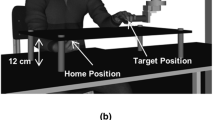Abstract
It is now well established that the accuracy of pointing movements to visual targets is worse in the full open loop condition (FOL; the hand is never visible) than in the static closed loop condition (SCL; the hand is only visible in static position prior to movement onset). In order to account for this result, it is generally admitted that viewing the hand in static position (SCL) improves the movement planning process by allowing a better encoding of the initial state of the motor apparatus. Interestingly, this wide-spread interpretation has recently been challenged by several studies suggesting that the effect of viewing the upper limb at rest might be explained in terms of the simultaneous vision of the hand and target. This result is supported by recent studies showing that goal-directed movements involve different types of planning (egocentric versus allocentric) depending on whether the hand and target are seen simultaneously or not before movement onset. The main aim of the present study was to test whether or not the accuracy improvement observed when the hand is visible before movement onset is related, at least partially, to a better encoding of the initial state of the upper limb. To address this question, we studied experimental conditions in which subjects were instructed to point with their right index finger toward their unseen left index finger. In that situation (proprioceptive pointing), the hand and target are never visible simultaneously and an improvement of movement accuracy in SCL, with respect to FOL, may only be explained by a better encoding of the initial state of the moving limb when vision is present. The results of this experiment showed that both the systematic and the variable errors were significantly lower in the SCL than in the FOL condition. This suggests: (1) that the effect of viewing the static hand prior to motion does not only depend on the simultaneous vision of the goal and the effector during movement planning; (2) that knowledge of the initial upper limb configuration or position is necessary to accurately plan goal-directed movements; (3) that static proprioceptive receptors are partially ineffective in providing an accurate estimate of the limb posture, and/or hand location relative to the body; and (4) that static visual information significantly improves the representation provided by the static proprioceptive channel.
Similar content being viewed by others
Author information
Authors and Affiliations
Additional information
Received: 23 July 1996 / Accepted: 13 December 1996
Rights and permissions
About this article
Cite this article
Desmurget, M., Rossetti, Y., Jordan, M. et al. Viewing the hand prior to movement improves accuracy of pointing performed toward the unseen contralateral hand. Exp Brain Res 115, 180–186 (1997). https://doi.org/10.1007/PL00005680
Issue Date:
DOI: https://doi.org/10.1007/PL00005680




